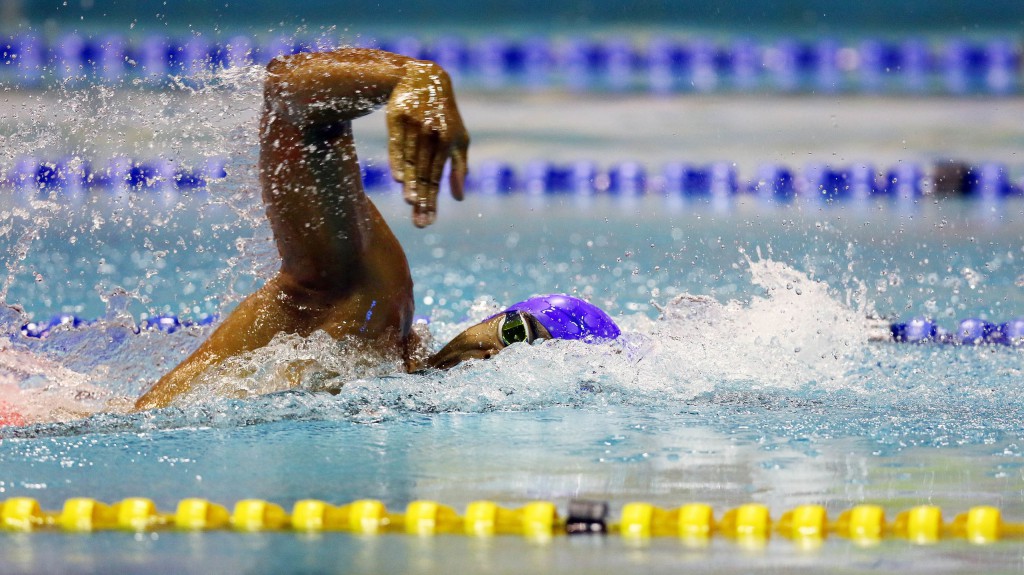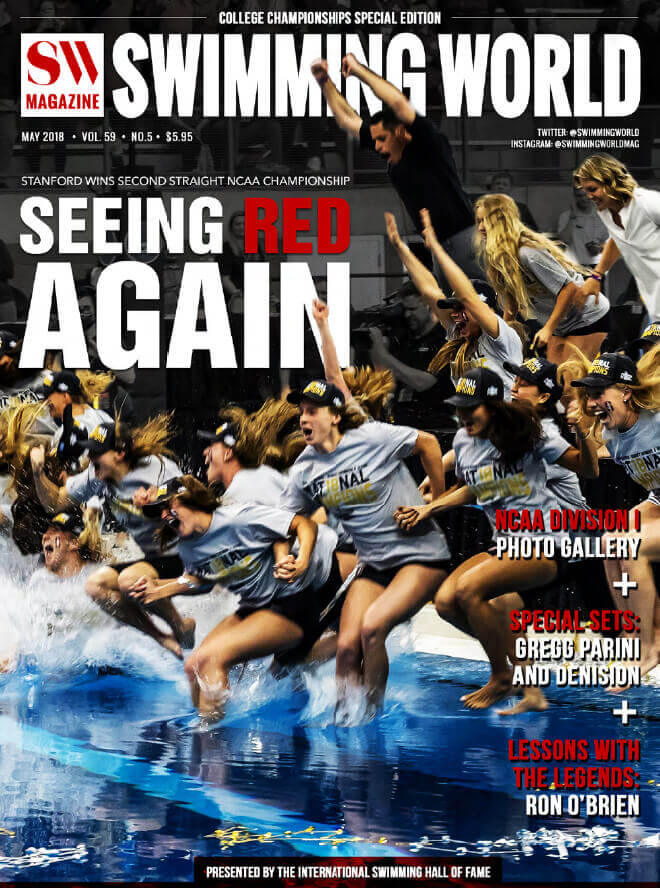Swimming World Presents “Swimming Technique Concepts: High Elbow or Deep Catch”

Swimming Technique Concepts: High Elbow or Deep Catch?
Two phrases that are commonly used for technique instruction are “high elbow” and “deep catch.” While these terms are not incorrect —either separately or jointly— their lack of precision leaves great opportunity for misinterpretation. For example, how does a coach or swimmer determine that the elbow was sufficiently “high” or the catch was sufficiently “deep?”
Fortunately, it is possible to qualify “high” and “deep” by specifying the relative orientation of body parts using a “cue.” There are guidelines to make cues precise with minimal chance of misinterpretation. According to Dr. Rod Havriluk, there are three types of cues: visual, auditory, and kinesthetic.
Swimmers can achieve precise control of body movements with strict focus on cues, providing the cues have specific information about the relative position and motion of body parts. Continual focus on cues can also help a swimmer achieve and maintain beneficial technique adjustments.
Sound easy? Maintaining focus on cues throughout a typical team training session presents a significant challenge that will be addressed in next month’s article.
Dr. Rod Havriluk is a sports scientist and consultant who specializes in swimming technique instruction and analysis. His unique strategies provide rapid improvement while avoiding injury. Learn more at the STR website: www.swimmingtechnology.com. You can contact Rod at info@swimmingtechnology.com. All scienti c documentation relating to this article, including scienti c principles, studies and research papers, can be provided upon demand.
To learn more about using high elbow and deep catch swimming technique concepts, check out the May 2018 issue of Swimming World Magazine, available now!
[College Championship Issue Photo by Peter H. Bick]
Get Swimming World Magazine and Swimming World Biweekly FREE When You Become A Member of the International Swimming Hall of Fame
Want More? Subscribe With This Special 2-Year Offer!
New! 1-Year Digital Only Subscription for just $29.95 Order Now!
FEATURES
016 JUST ENOUGH
by Dan D’Addona, David Rieder and Annie Grevers
With one event remaining, Texas, Cal and Indiana all had a chance to win the men’s NCAA Division I Championships. But it was the Longhorns who held on to capture their fourth straight team title in what turned out to be the closest finish in 16 years.
MEN’S NCAA DIVISION I MINI-FEATURES:
019 CAELEB DRESSEL: SO MUCH MORE
021 MEN’S 200 FREE: A PORTENT OF THINGS TO COME
022 NC STATE: ON THE RISE
023 HOOSIER BREASTSTROKE: LETTING LOOZE
025 MEN’S NCAA DIVISION I PHOTO GALLERY
photos by Peter H. Bick
026 THE STANFORD SUPREMACY
by Dan D’Addona, David Rieder and Annie Grevers
Stanford’s women’s swimming team established its “identity” a year ago by dominating the women’s NCAA Division I Swimming and Diving Championships and winning its first team title in 19 years. This year’s action-packed sequel was even more thrilling!
WOMEN’S NCAA DIVISION I MINI-FEATURES:
029 TEXAS A&M: BUILDING ON THE BULTMAN LEGACY
030 ELLA EASTIN: CONFIDENT AND FOCUSED
031 MICHIGAN, LOUISVILLE, TEXAS: EXCEEDING EXPECTATIONS
033 WOMEN’S NCAA DIVISION I PHOTO GALLERY
photos by Peter H. Bick
035 STREAKS ALIVE…MOSTLY
by Chandler Brandes and Andy Ross
Queens, Emory and Indian River continued their winning streaks at their respective college national championships, but Denison, Savannah College of Art and Design and Keiser are ready to start (or restart) some streaks of their own.
COACHING
010 LESSONS WITH THE LEGENDS: RON O’BRIEN
by Michael J. Stott
014 THE RELATIVE ORIENTATION OF BODY PARTS: HIGH ELBOW OR DEEP CATCH?
by Rod Havriluk
Swimmers can achieve precise control of body movements—such as “high elbow” and “deep catch”—with strict focus on cues, providing the cues have specific information about the relative position and motion of body parts.
040 OFF-SEASON TRAINING: A BUILDING BLOCK FOR FUTURE SUCCESS
by Michael J. Stott
042 Q&A WITH COACH ANDY BOYCE
by Michael J. Stott
043 HOW THEY TRAIN SAM POSTMUS
by Michael J. Stott
TRAINING
039 DRYSIDE TRAINING: WET-LAND TRAINING
by J.R. Rosania
JUNIOR SWIMMER
045 UP & COMERS: MENA BOARDMAN
by Taylor Brien
COLUMNS & SPECIAL SECTIONS
008 A VOICE FOR THE SPORT
013 BEYOND THE YARDS
041 THE OFFICIAL WORD
046 GUTTER TALK
048 PARTING SHOT




